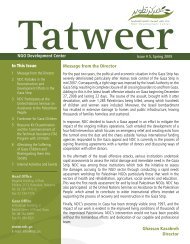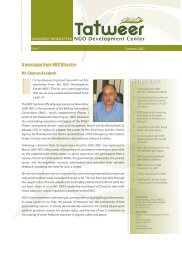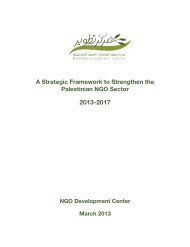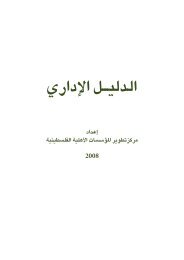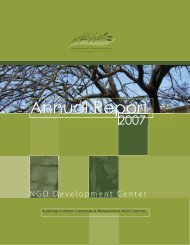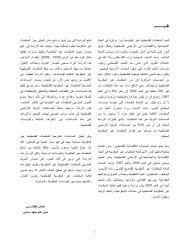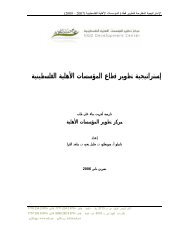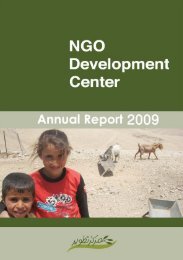Tracking External Donor Funding.pdf - NDC
Tracking External Donor Funding.pdf - NDC
Tracking External Donor Funding.pdf - NDC
Create successful ePaper yourself
Turn your PDF publications into a flip-book with our unique Google optimized e-Paper software.
2.2.6.1 Aid versus GNI<br />
As table 7 shows, the percentage of aid in comparison to<br />
GNI has been extremely high leading up to the 2002<br />
height of the Second Intifada. By constituting around a<br />
third of GNI, the sustainability of the Palestinian<br />
economy is questionable – as the removal of aid will<br />
bring disastrous effects. The huge increase in aid flows<br />
with modest growth in GNI means that in 2008, external<br />
aid constituted as much as 60% of the Palestinian GNI.<br />
2.2.6.2 Aid versus Government Expenditures<br />
As figure 9 shows, aid flows in 2002 were around 163%<br />
of government expenditures as a result of the<br />
humanitarian crisis that shifted financing from<br />
Development to Emergency. During the years 2000 and<br />
2005, aid constituted as much as half of government<br />
expenditures, as the PA began to accumulate massive<br />
deficits. In 2006 aid was almost 100% of public<br />
expenditures, as the PA was prevented from collecting<br />
taxes or clearance revenues by Israel. These revenues<br />
were eventually freed up in the latter half of 2007 and the<br />
beginning of 2008. Despite the return of other revenue<br />
streams, aid as a percentage of government expenditure<br />
increased from 73% and 99% between 2007 and 2008.<br />
Figure 9: <strong>External</strong> Aid versus Government Expenditures<br />
(1999-2008 – Millions USD)<br />
3500<br />
3000<br />
2500<br />
2000<br />
1500<br />
1000<br />
500<br />
0<br />
1999 2000 2001 2002 2003 2004 2005 2006 2007 2008<br />
Gov't Expenditure<br />
International Aid<br />
Source: PCBS- National Accounts (2009a), OECD/DAC and World Bank Databases<br />
(2009)<br />
2.2.6.3 Aid versus Government Deficits<br />
Since 2000, the PA has recorded high levels of deficit.<br />
However, more recently aid flows through PRDP have<br />
generated a surplus, allowing the government to carry<br />
out development projects in addition to emergency and<br />
restructuring programs. Between 2005 and 2008 the<br />
bottom line changed from a 275 Million USD deficit to a<br />
surplus of 270 Million.<br />
Table 8: Government Budget Surplus (Deficit) Before and After Aid (1997-2008 – Millions USD)<br />
1999 2000 2001 2002 2003 2004 2005 2006 2007 2008<br />
Net Domestic Revenues Public (Gov't) Revenues 942 939 273 290 747 1,050 1,370 722 1,616 1,780<br />
Total Expenditure and Net Lending Public (Gov't)<br />
Expenditures<br />
937 1,199 1,095 994 1,240 1,528 1,994 1,426 2,567 3,273<br />
Recurrent Budget Surplus (Deficit) before Aid-<br />
Budget support<br />
5 -260 -822 -704 -493 -478 -624 -704 -951 -1,493<br />
Recurrent Budget Surplus (Deficit) After Aid-<br />
Budget support<br />
28 -206 -291 -236 -232 -125 -275 34 61 270<br />
Source: PCBS – National Accounts (2009a)<br />
Note: In 2005, external donors withheld aid to the PA as a consequence for not meeting a series of benchmarks.<br />
17


